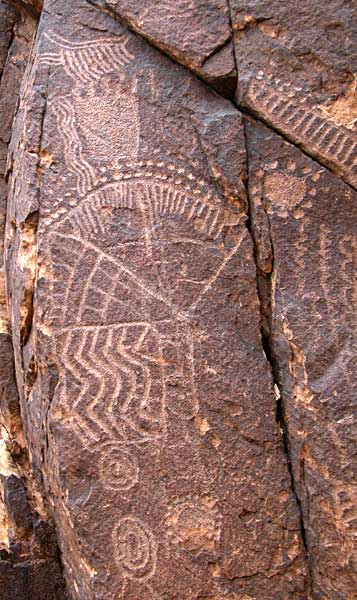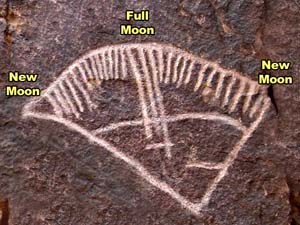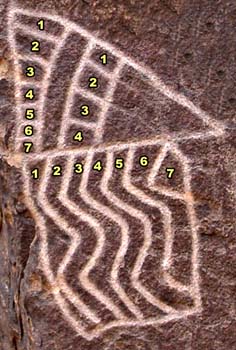
Parowan Gap Lunar Calendar
This lunar calendar is located on the north side of the Parowan canyon gap. The glyphs are symbolic of the lunar cycle with the moon traveling from a new moon, through a crescent, to a full moon and back again. The panel also relates the lunar cycle to that of the solar cycle. Lets examine how.
 |
| Lunar pie calendar. |
One of the upper figures shows a shape much like a piece of pie with the rounded portion pointing upward. Along the rounded arc are 27 various sized lines that extend down towards the vertex. The addition of the outer two edge lines gives a total of 29 lines, which is the period of a lunation or the period from new moon to new moon. The actual number is 29.53059 days. During a lunation the moon travels from its origin to the southern most extreme position, to its northern most extreme position and back to its origin.
 |
| Lunar & Solar calendar relationship. |
Let the left side represents the new moon in the west just as the sun sets. The three longer lines represent the three days of full moon. The lines in between represent the days from new moon, to crescent, to gibbous, then to full moon. The lines to the right track the moon through its various stages until it is a thin crescent visible in early morning to the east.
Just below the upward facing wedge is another pie shaped wedge that faces the left or to the west. Its purpose is to tie the lunar and solar calendars together. The wedge represents the angle through which the moon and sun swing between solstices. On the left is a column of 7 sections representing 6 lunar months with a possible 7th full moon. In the middle is a column of 4 segments. These represent 4 solar months of 45 days.
 |
| Solar disk with 12 lunations. |
Below this is a block containing 6 full wavy lines with a partial wavy line. According to Nal Morris, these represent 6 lunar months between solstices showing the motion of the moon along the horizon. Because there are 6.1844 lunations between solstices, the partial wavy line represents the fractional lunation.
To the right is a disk with 12 dots around it. The central disk represents the Sun with 12 lunar lunations surrounding it. Other calendar symbology surrounds these glyphs and more information will be added.